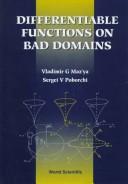| Listing 1 - 7 of 7 |
Sort by
|

ISBN: 9789810227678 9810227671 Year: 1997 Publisher: Singapore: World scientific,
Abstract | Keywords | Export | Availability | Bookmark
 Loading...
Loading...Choose an application
- Reference Manager
- EndNote
- RefWorks (Direct export to RefWorks)
Book
Abstract | Keywords | Export | Availability | Bookmark
 Loading...
Loading...Choose an application
- Reference Manager
- EndNote
- RefWorks (Direct export to RefWorks)
Book
ISBN: 9780821844243 0821844245 Year: 2008 Volume: 79 Publisher: Providence, R.I. American Mathematical Society
Abstract | Keywords | Export | Availability | Bookmark
 Loading...
Loading...Choose an application
- Reference Manager
- EndNote
- RefWorks (Direct export to RefWorks)
Book
ISBN: 3034601700 9786612834875 3034601719 1282834878 Year: 2010 Publisher: Basel : Birkhauser,
Abstract | Keywords | Export | Availability | Bookmark
 Loading...
Loading...Choose an application
- Reference Manager
- EndNote
- RefWorks (Direct export to RefWorks)
The purpose of this book is to give a comprehensive exposition of the theory of boundary integral equations for single and double layer potentials on curves with exterior and interior cusps. The theory was developed by the authors during the last twenty years and the present volume is based on their results. The first three chapters are devoted to harmonic potentials, and in the final chapter elastic potentials are treated. Theorems on solvability in various function spaces and asymptotic representations for solutions near the cusps are obtained. Kernels and cokernels of the integral operators
Boundary element methods -- Congresses. --- Boundary element methods. --- Nonlinear theories -- Congresses. --- Nonlinear theories. --- Boundary value problems --- Boundary element methods --- Dirichlet problem --- Neumann problem --- Elasticity --- Integral equations --- Civil & Environmental Engineering --- Mathematics --- Calculus --- Operations Research --- Physical Sciences & Mathematics --- Engineering & Applied Sciences --- Integral equations. --- Equations, Integral --- BEM (Engineering analysis) --- BIE analysis --- BIE methods --- Boundary element analysis --- Boundary elements methods --- Boundary integral equation analysis --- Boundary integral equation methods --- Boundary integral methods --- Mathematics. --- Integral Equations. --- Functional equations --- Functional analysis --- Numerical analysis
Book
ISBN: 9783540694922 Year: 2009 Publisher: Berlin Heidelberg Springer Berlin Heidelberg
Abstract | Keywords | Export | Availability | Bookmark
 Loading...
Loading...Choose an application
- Reference Manager
- EndNote
- RefWorks (Direct export to RefWorks)
The purpose of this book is to give a comprehensive exposition of the theory of pointwise multipliers acting in pairs of spaces of differentiable functions. The theory was essentially developed by the authors during the last thirty years and the present volume is mainly based on their results. Part I is devoted to the theory of multipliers and encloses the following topics: trace inequalities, analytic characterization of multipliers, relations between spaces of Sobolev multipliers and other function spaces, maximal subalgebras of multiplier spaces, traces and extensions of multipliers, essential norm and compactness of multipliers, and miscellaneous properties of multipliers. Part II concerns several applications of this theory: continuity and compactness of differential operators in pairs of Sobolev spaces, multipliers as solutions to linear and quasilinear elliptic equations, higher regularity in the single and double layer potential theory for Lipschitz domains, regularity of the boundary in L_p-theory of elliptic boundary value problems, and singular integral operators in Sobolev spaces.
Algebra --- Functional analysis --- Partial differential equations --- differentiaalvergelijkingen --- algebra --- functies (wiskunde)
Book
ISBN: 9783034601719 9783034601726 9783034601702 Year: 2010 Publisher: Basel Birkhäuser Basel
Abstract | Keywords | Export | Availability | Bookmark
 Loading...
Loading...Choose an application
- Reference Manager
- EndNote
- RefWorks (Direct export to RefWorks)
An equation of the form ??(x)? K(x,y)?(y)d?(y)= f(x),x?X, (1) X is called a linear integral equation. Here (X,?)isaspacewith ?-?nite measure ? and ? is a complex parameter, K and f are given complex-valued functions. The function K is called the kernel and f is the right-hand side. The equation is of the ?rst kind if ? = 0 and of the second kind if ? = 0. Integral equations have attracted a lot of attention since 1877 when C. Neumann reduced the Dirichlet problem for the Laplace equation to an integral equation and solved the latter using the method of successive approximations. Pioneering results in application of integral equations in the theory of h- monic functions were obtained by H. Poincar´ e, G. Robin, O. H¨ older, A.M. L- punov, V.A. Steklov, and I. Fredholm. Further development of the method of boundary integral equations is due to T. Carleman, G. Radon, G. Giraud, N.I. Muskhelishvili,S.G.Mikhlin,A.P.Calderon,A.Zygmundandothers. Aclassical application of integral equations for solving the Dirichlet and Neumann boundary value problems for the Laplace equation is as follows. Solutions of boundary value problemsaresoughtin the formof the doublelayerpotentialW? andofthe single layer potentialV?. In the case of the internal Dirichlet problem and the ext- nal Neumann problem, the densities of corresponding potentials obey the integral equation ???+W? = g (2) and ? ???+ V? = h (3) ?n respectively, where ?/?n is the derivative with respect to the outward normal to the contour.
Digital
ISBN: 9783540694922 Year: 2009 Publisher: Berlin, Heidelberg Springer Berlin Heidelberg
Abstract | Keywords | Export | Availability | Bookmark
 Loading...
Loading...Choose an application
- Reference Manager
- EndNote
- RefWorks (Direct export to RefWorks)
Algebra --- Functional analysis --- Partial differential equations --- differentiaalvergelijkingen --- algebra --- functies (wiskunde)
| Listing 1 - 7 of 7 |
Sort by
|

 Search
Search Feedback
Feedback About UniCat
About UniCat  Help
Help News
News